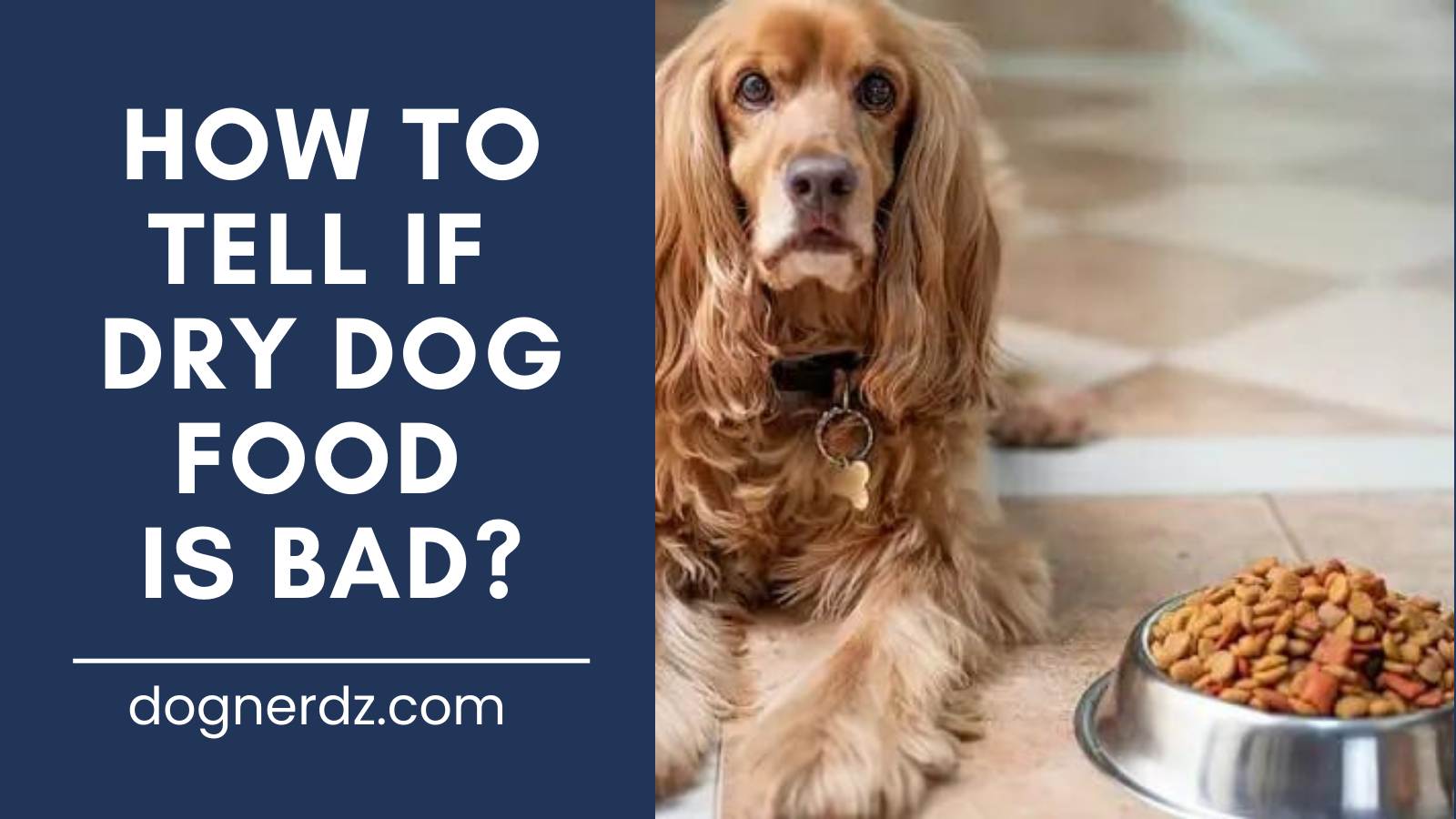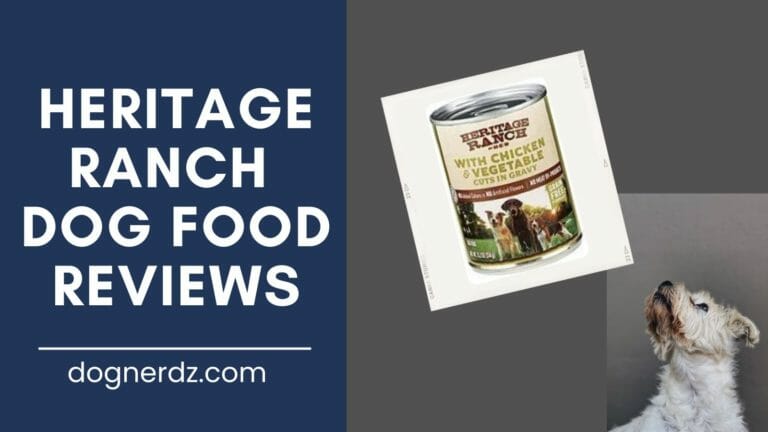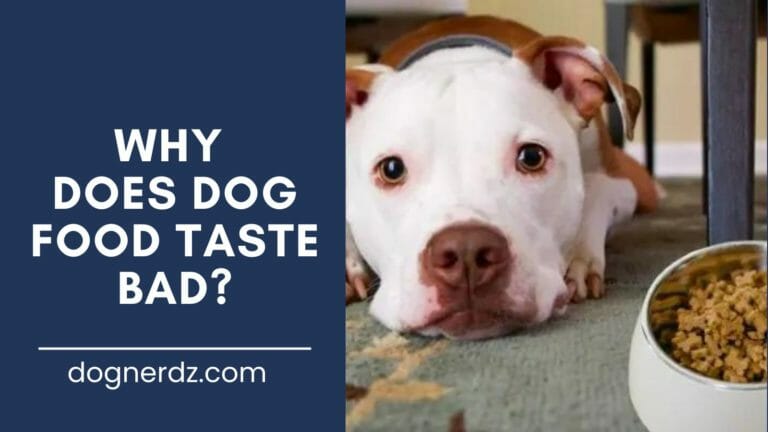How to Tell if Dry Dog Food is Bad?
Table of Contents
Dog lovers want nothing but the best for their furry pals, especially when it’s chow time. The right grub packs all the goodies our pooches need to jump, run, and cuddle their way to a vibrant, full life.
On the flip side, dog food can also be the culprit for stomach issues and even allergies. Today, we’re going to tackle how to tell if dry dog food has gone bad.
You don’t want to be inadvertently feeding your dog bad dog food, so let’s go through how we can tell if your pet food has gone bad.
What to Look for In Dry Dog Food
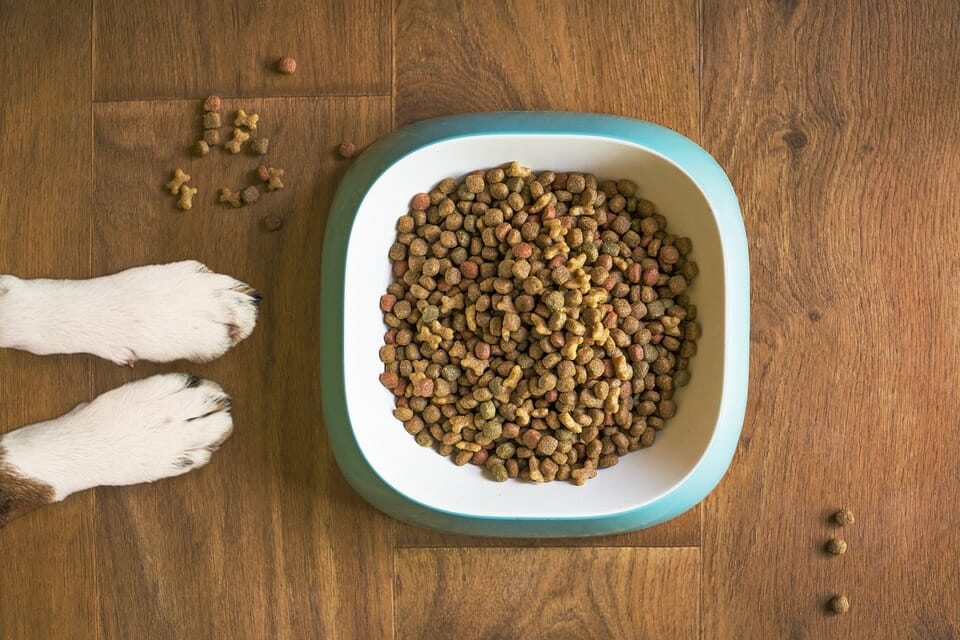
Here we will do a deep dive into a few ways to check if dry dog food and canned dog food have gone bad.
The Date of Expiry
Perhaps the most obvious action to tell if dog food has gone bad is to look at its shelf life, indicated by the expiration date. Similar to the food we consume, the expiration date is a guideline as to when the food loses its freshness. Some may argue that a day or two past the expiration date is acceptable, but we would only condone that if you are finishing off a pack of food.
For people buying a fresh new bag of pet food, make sure you give yourself and your dog ample time before it’s past its expiration date. For dog food, there is also a best by date, which ensures the health and safety of your dog if the food is consumed within the labeled best before or best by date. Usually, you can expect a shelf life of a year to a year and a half.
It’s crucial to also keep in mind that the expiration date and best by dates is for unopened dog food bags. Once it has been opened, it’s best to consume the food in a timely manner within the month.
The reason pet food manufacturers have a best by date for pet foods is due to oxidation. Once the original bag or canned food has been opened, air and moisture will start to seep in and degrade the food. Over time, the degradation will lead to food spoilage.
How to Tell if Food is Bad?
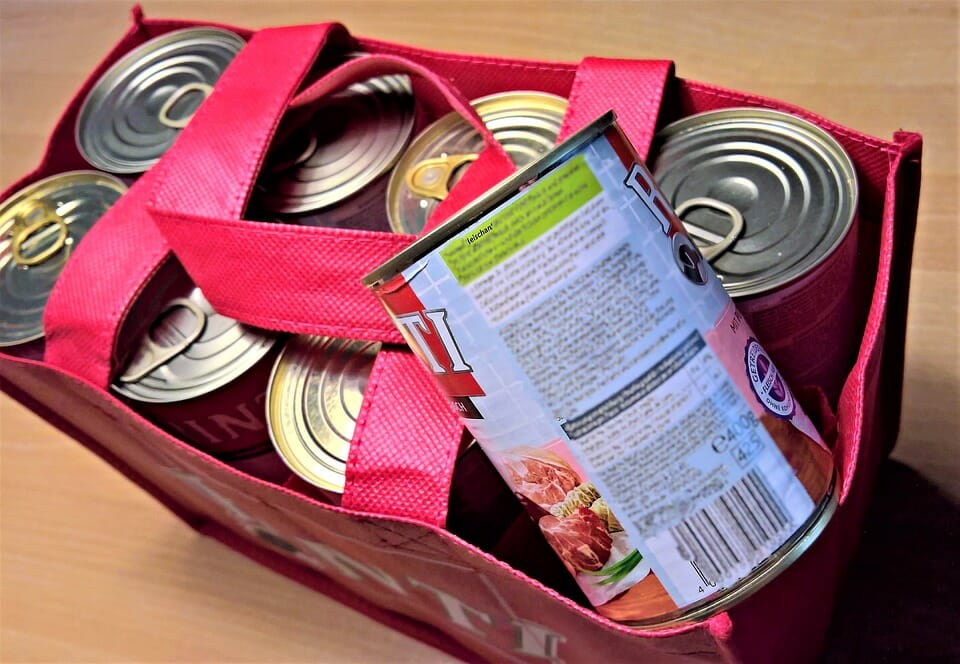
from Pixabay
There may be a chance you purchase an original bag of food that has spoiled even though it hasn’t been opened and isn’t past its expiration date. There is also a chance the kibble has been opened for too long and started to spoil. In both cases, there are certain features to be aware of when inspecting your dog’s food.
+ Check the Odor
More than likely there will be a rancid smell to the canned dog food or dry dog food if it is past its shelf life. The smell should be pretty noticeable, but if it’s faint to you, your dog should be able to detect it. So if your pooch is avoiding his food and you notice the aroma is slightly off, then chances are it is bad.
+ Check the Appearance
Sometimes the spoilage is easily detected by the eye. If you notice any mold or even bugs of some sort, then it is a definite sign the food went bad
If you haven’t noticed anything detectable by these two senses but your dog is avoiding the food or has started to feel ill, then you should inspect it more closely. The food you feed your dog could be the catalyst to physical symptoms.
If you live in a place where heat and humidity are an issue, then a dog’s food without proper storage will impact the shelf life and freshness.
How Should I Store Dog Food?
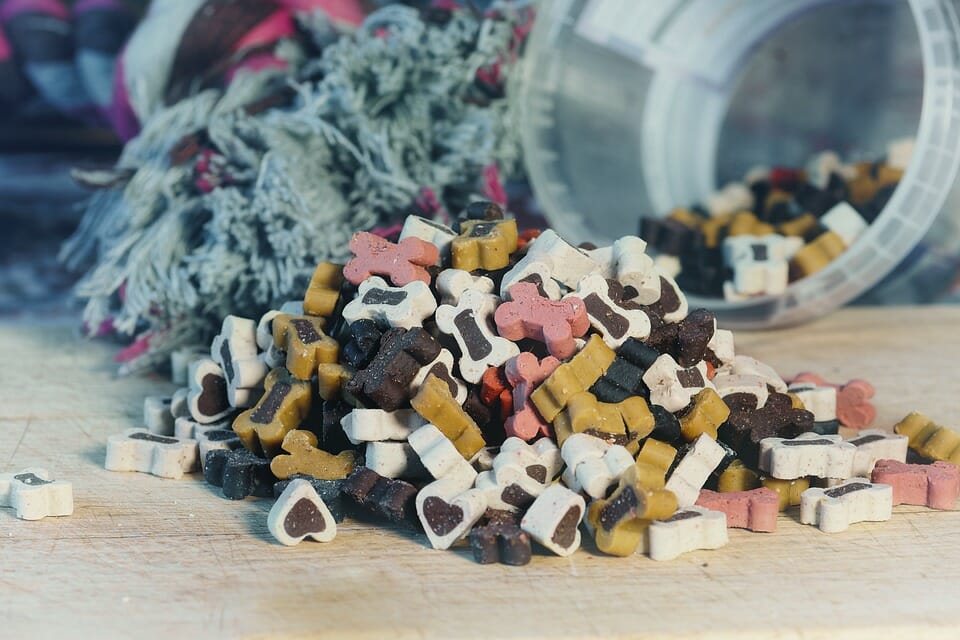
The preservation of either dry dog food or canned dog food is the same – it all hinges on the storage container. Pet foods usually come in a bag, but once it’s opened, then the contents are compromised. There are dog food bags that come with a Ziploc seal, and this will suffice in places with dry air and moisture control since a dog food bag is optimized for this. However, in an environment where it’s hot and moist, food storage methods are more important than ever. You can’t just rely on a sealed bag.
In areas such as these, food in the bag should be transferred to a storage container. If we’re talking about wet dog food, then we would also suggest your dog’s food be transferred to a properly sealed container when opened or stored in a cool dry place if not. Opened cans or ones stored in a container should be refrigerated. An airtight dry food bin will help make sure your dog’s food stays fresh for longer.
Subscription
What about Treats?
Dog treats are created in a different way than dog foods, but the short answer is yes, they can still go bad. The shelf life of dog treats depends on the ingredients and if there are preservatives. Of course, we hope that the treats you feed or dog are as natural and organic as possible.
Much like dog food, their treats should also come with a date of expiry and an estimated shelf life with a best before date. Keep in mind that the more natural the treats are, the quicker they should be consumed after you open the bag. For dog treats, they usually come in a resealable food bag, so all you need to do is store them in a cool dry place.
If you make your own dog treats, such as cookies, you can store them accordingly to how you would human treats.
The same logic applies when trying to determine if dog treats have spoiled, and that is by looking out for a rancid odor, discoloration, mold, and careful monitoring of expiration dates.
What Happens if My Dog Eats Bad Dog Food?
Let’s say your dog happens to eat bad dog food, what can happen? We’re sure that question is plaguing the minds of many pet parents because the symptoms are similar to a dog eating almost anything else they shouldn’t eat.
The most obvious sign of your dog eating something he isn’t supposed to be food poisoning. This can come from bad food and spoiled treats, but other causes range from eating feces, picking up dead animals on walks, and eating something their system cannot handle.
How can you be sure it’s food poisoning? The signs are quite obvious and they manifest in vomiting, a lack of appetite, lethargy, diarrhea, and more. In more severe cases, your dog can exhibit even more frightening symptoms such as seizures and tremors. Of course, these are reserved for the more serious cases but the most common symptoms are lethargy, vomiting, and an upset stomach.
What to Do If My Dog Ate Bad Dog Food?
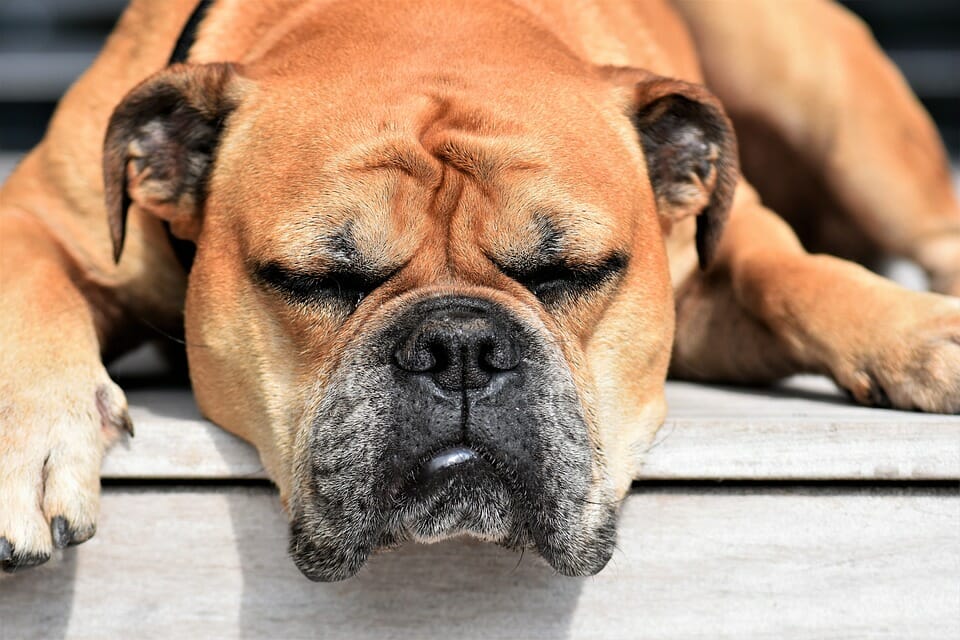
If your beloved dog has eaten bad food and is showing the above signs we mentioned, let him get it out. Sometimes once your dog gets the spoiled dry dog food or wet food out of his system, he should slowly regain some normalcy. One thing to make sure to do during the expulsion period is to keep water accessible. Vomiting and an upset stomach lead to dehydration in your dog.
As a rule of thumb, give your dog one day or 24 hours to recover. He may not be 100% after the first day, but he should display signs of recuperation If not, then it’s time to take a trip to the vet. If he seems to get better only to have his condition worsen again over the next few days, then also call your vet.
As a dog parent, your concerns are always valid when it comes to the well-being of your dog. It never hurts to schedule an appointment regardless of how serious the food poisoning is.
Frequently Asked Questions
What are the signs of spoiled dry dog food?
Spoiled dry dog food can exhibit a range of telltale signs that are hard to miss. The first thing you may notice is a pungent, rancid odor emanating from the bag or container. It can be described as a mixture of rotting garbage and a neglected compost heap.
If you give it a closer look, you might find mold or fungus growth, which can appear as fuzzy patches or discoloration on the kibble. Another dead giveaway is the presence of insects or bugs crawling around in the food.
Imagine opening a bag of dog food only to find a chaotic scene reminiscent of a horror movie, with creepy crawlies scurrying about. Trust me, you won’t be able to unsee that sight. So, if you come across any of these signs, it’s a clear indicator that your dog’s food has gone bad.
How can I tell if my dog’s food has gone bad?
Identifying spoiled dog food is crucial for your pup’s well-being. One way to determine if it has gone bad is by examining its color. Fresh dry dog food typically has a vibrant, uniform hue.
However, if you notice any drastic changes in color, like a shift towards a dull or faded appearance, it’s a red flag. Picture a once-bright rainbow transforming into a gloomy, gray sky.
Furthermore, pay attention to the texture of the kibble. If it feels unusually greasy or sticky, almost like touching a slimy slug, it’s a clear indication of spoilage. Lastly, if you see any signs of moisture or clumping in the dog food, it’s time to chuck it in the trash. Remember, your dog’s food should be dry and crisp, not resembling a messy, soggy swamp.
What is the shelf life of dry dog food?
The shelf life of dry dog food is an important factor to consider when ensuring your furry friend’s nutritional needs are met. Typically, dry dog food has a shelf life of around one year, but this can vary depending on the specific brand and formulation.
Think of it like a countdown timer that starts ticking the moment you bring the bag home. However, it’s crucial to remember that this timeline is not set in stone. Factors such as the storage conditions, quality of packaging, and the presence of preservatives can all influence the longevity of the dog food.
So, make sure to check the expiration date on the bag and follow the storage instructions provided by the manufacturer to ensure your dog gets the freshest and safest meals.
What are the potential health risks if my dog consumes bad dry food?
Feeding your dog spoiled dry food can have dire consequences for their health. Just like humans, dogs can suffer from food poisoning. Imagine your poor pup experiencing stomach cramps, vomiting, and diarrhea, leaving them weak and miserable.
In severe cases, consuming spoiled food can even lead to more serious health issues, such as organ damage or bacterial infections. It’s like a ticking time bomb, ready to wreak havoc on your furry companion’s well-being.
So, it’s crucial to be vigilant and never compromise on their safety. Always inspect the dry dog food before feeding it to your pooch, ensuring they receive nourishment instead of falling prey to potential health risks.
Can dry dog food go bad if it’s not stored properly?
Absolutely! Dry dog food is not immune to spoilage, even if it seems resilient. Improper storage can quickly transform a fresh bag of dog food into a breeding ground for bacteria and other nasties.
Let’s dive into a real-life example to illustrate this. Imagine leaving a bag of dry dog food open and exposed to the humid summer air. Over time, moisture seeps into the kibble, creating a perfect environment for mold or fungal growth.
It’s like a science experiment gone wrong, with microscopic organisms partying in your dog’s food. Furthermore, if you store the dog food in a warm or sunny location, it can accelerate the spoilage process, like a greenhouse cranking up the heat. So, remember to seal the bag tightly, keep it in a cool and dry place, and avoid storing it near direct sunlight. Your furry friend’s health depends on it!
How long can I keep an opened bag of dry dog food?
You can keep an opened bag of dry your dog’s food for about 4-6 weeks. It is recommended to consume the dry food within that time frame to ensure freshness and nutritional value.
Pay attention to the expiration dates and do not feed your dog the food that has passed the dates when opened.
Conclusion
Ensuring your dog is not consuming anything harmful is a basic job for us pet parents. What some might not consider is the hazardous element could be the very food they eat.
Make sure you check the expiry date, best before date, and inspect the food thoroughly before feeding. Once the bag has been opened, make sure to store it in a sealed container if needed in a cool and dry place.

